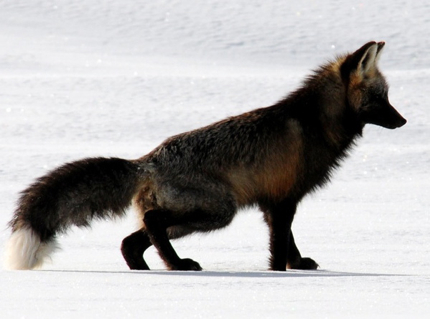 Red fox with a rare black coat hunting in Lamar Valley (Photo by Pauline Murrill) Red foxes usually live up to their name in terms of the color of their coats—most display reddish-orange fur highlighted with black socks and a white-tipped tail. Yet foxes can also experience varied color phases of silver, gray, yellow, and—as this animal in Yellowstone demonstrated last week—a vibrant black.
Red fox with a rare black coat hunting in Lamar Valley (Photo by Pauline Murrill) Red foxes usually live up to their name in terms of the color of their coats—most display reddish-orange fur highlighted with black socks and a white-tipped tail. Yet foxes can also experience varied color phases of silver, gray, yellow, and—as this animal in Yellowstone demonstrated last week—a vibrant black.
Lamar Valley, where this fox was spotted, is prime habit for the red fox, which prefer forests and sagebrush grasslands as habitat. A nocturnal creature, it subsists mostly on hunting mice, voles and insects, but will also eat plants as well. Red foxes are mostly solitary and usually forage alone or in mated pairs. A vixen (female fox) gives birth to 2-12 kits in late April to early May, which are weaned by the end of summer. Kits at birth are typically brown or grey and start growing the distinctive red coat after about a month.
A black color phase is a rare occurrence, usually described as a “cross” pattern with black stretching across the shoulder and back over a brown or red undercoat. Another unusual coat color on the red fox has been spotted consistently at higher elevations in the park. Deemed “The Yellow Fox of the Yellowstone,” scientists are currently studying this creamy-yellowish creature to determine if it represents a new subspecies.
For a chance to view red foxes in Yellowstone, the non-profit Yellowstone Association Institute offers a variety of field classes about the red fox such as Lesser-Known Carnivores and Xanterra's Yellowstone National Park Lodges features a series of wildlife watching adventures.
